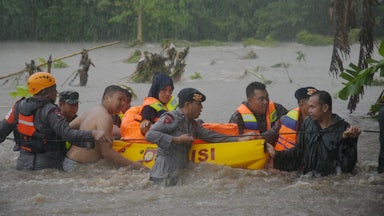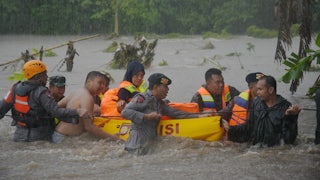Last week, the U.S. government tiptoed a little closer to the world of science fiction. In a 44-page report it seemed at pains to say was not its own idea, the White House laid out a five-year research plan to explore the development and eventual deployment of solar radiation management, or SRM, technology—the idea of blocking out the sun to slow down climate change.
Skeptics say SRM is dangerous and untested, and has a laundry list of potential impacts that, similarly, seem straight out of a disaster movie: worsened winters, disappearing monsoons, damage to the ozone layer, and droughts that could devastate already dry regions. In recent years, prominent climate scientists have organized to call for a total moratorium on researching and testing the technology. But others say its deployment is becoming virtually inevitable as the world’s biggest polluters—the United States among them—appear incapable of making the large-scale adjustments necessary to avoid the catastrophic impacts of climate change.
“The question becomes, what should we do, given that we’re not doing what we should be doing?” said Toby Svoboda, an environmental ethicist at Colgate University and the author of a book on the ethics of climate engineering. “Politically, this is pretty significant, that the Biden administration would signal their openness to this.”
For the uninitiated, SRM encompasses an array of highly controversial geoengineering techniques that minimize the warming impact of the sun—and thus the worsening impacts of human-caused climate change—primarily by injecting reflective chemical compounds into the earth’s atmosphere.
Ordered by Congress as part of a 2022 appropriations bill, the new White House report stops short of issuing a new policy directive on the technology or its use. But it does suggest developing scenarios in which SRM might be used, and even supports testing the technology in small-scale, real-world deployments.
In calling for more study, the report acknowledges that the potentially irreversible impacts of SRM on human health and the environment are still largely unknown. But it proposes what it calls a “risk versus risk” approach, which would weigh any possible impacts that could be discerned from SRM against potentially worse outcomes if the world, as expected, fails to meet climate targets.
While recognizing its drawbacks may be significant, the report largely frames its key research questions about SRM in a positive, market-friendly light, asking how the technology might ensure the survival of “natural capital dividends,” “bolster the weakest links in global and national supply chains,” and “reduce the risk of housing, insurance, and other market failures.”
And while the report acknowledges that deploying SRM technology would come with “significant geopolitical risks,” it also says the U.S. should “prepare … for possible deployment of SRM by other public or private actors” and develop the tools needed to detect it.
The report has not come too soon. Some limited SRM technology has already been deployed in China to mitigate the impact of droughts. Billionaire investors like Bill Gates, George Soros, and Jeff Bezos have poured millions into SRM research. And venture capital–backed private enterprises are beginning to actively test the limits of current regulations.
These recent developments have increased calls for a global agreement governing research and use of SRM technology. But while the White House report says some level of global cooperation is in America’s “best interest,” its recommendations fall far short of an international agreement on ground rules for research and deployment.
Shuchi Talati, a former Biden appointee to the Department of Energy and founder of the Alliance for Just Deliberation on Solar Geoengineering, said the report may nonetheless act as an “incentive” for these groups to realize that they “deserve a seat at this table.”
“The fact that this report exists encourages more countries to think about their role in this space,” she said.
But other experts said the report shows a global framework for SRM technology is increasingly unlikely. The failure of recent climate agreements to bind key contributors to emissions, like the U.S., has many preparing for the likelihood that the technology is developed—and even deployed—by a country or company acting unilaterally.
Make Sunsets, the V.C.-backed firm that sold individual credits for sulfur dioxide released into the air via balloons, made itself an example recently of how easily an independent actor can take advantage of the current lack of regulations. The venture was widely criticized by industry insiders for its technique, as well as the lack of concrete data on the actual cooling effects of its work, and was shut down by the Mexican government shortly after it began releasing balloons in Baja California earlier this year. But it’s not difficult to imagine a slightly more sophisticated firm finessing regulators ahead of time to launch similar projects that won’t get shut down—and could have a wide array of possible and unpredictable side effects.
“Given that they are developing it, eventually, somebody will try it,” said Rita Floyd, an associate professor in conflict and security at the University of Birmingham. “It’s inevitable it will happen, at least on a small scale.”
Any unilateral deployment would likely pose some serious ethical dilemmas. The most promising method of SRM, known as stratospheric aerosol injection, works by mimicking the effects of a volcanic eruption, like the 1815 event that produced Europe’s infamous “year without summer.” As such, its effects are exceedingly difficult to predict and nearly impossible to contain.
The benefits are also likely to be temporary. Stopping aerosol injections, experts say, would produce a “termination shock”—a rapid and highly damaging increase of temperatures. Any deployment would soon create a global dependency on the unending, costly use of the technology.
“There’s a global impact,” said Svoboda. “That, of course, makes it a question of, what are the ethics of making a decision for the entire planet?”
To date, interest in SRM technology has largely come from major emitters like the U.S. and China, Lili Fuhr, a deputy director at the Center for International Environmental Law, told me. Where research has been proposed, Indigenous and marginalized groups have generally objected.
“It’s really researchers and rich people from the most polluting countries in the world who have been calling for this,” Fuhr said.
That has some experts worried that growing U.S. interest in SRM technology is really reflective of a deeper unwillingness to make substantive progress on less flashy climate goals, like reducing overall emissions. “It’s very aligned with some of the techno-fixated thinking that is coming out of Silicon Valley,” said Fuhr.
“There is a worry that, perhaps, the American public or some segment of it might be duped into thinking this is a full, complete, easy fix,” said Svoboda. “It most certainly isn’t—nobody who’s informed on the subject thinks this is a silver bullet.”
But other ethicists say continued inaction on climate change may well force the rest of the world into a position where the nonuse of SRM technology is no longer ethically defensible. Floyd said that the most likely ethical grounds for its deployment would be to avoid a “tipping-point scenario,” sometimes referred to by geoengineering experts as “shaving the peak”—minimizing the extreme impacts of climate change in vulnerable ecosystems like the Arctic.
It is likely only after the unilateral deployment of this technology in an ostensibly justifiable case like this, Floyd told me—or, perhaps, unregulated, for-profit deployment by private sector actors like Make Sunsets—that global regulations will follow. She said that these scenarios put enormous pressure on small-state actors with “symbolic power,” like people of sinking Pacific islands or the Indigenous people of the Arctic, to decide whether to legitimize or delegitimize the technology.
But it may be that the horse is already out of the stable. Fuhr told me that one of the great successes of climate scientists to date has been to maintain the public perception of SRM as “not a wise idea, [but] a very dangerous idea.”
Now, she said, “we are at a real risk of … normalizing solar geoengineering as just another tool in the toolbox.… Not science fiction, not something scary—but something that could really happen.”










